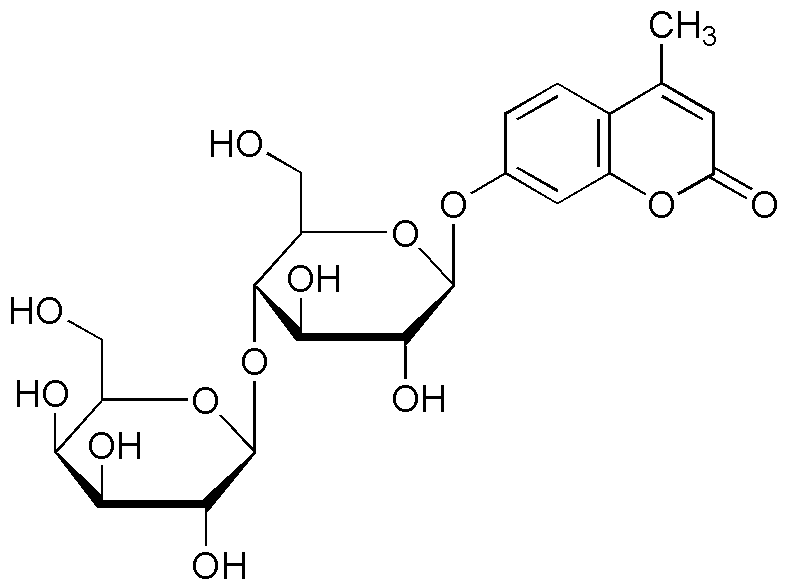4-Methylumbelliferyl-b-D-lactoside is widely utilized in research focused on:
- Enzyme Activity Assays: This compound is commonly used as a substrate in enzyme assays to measure the activity of β-galactosidase. Its fluorescence upon hydrolysis allows for sensitive detection, making it invaluable in biochemical research.
- Microbial Identification: It serves as a selective substrate for identifying specific bacteria, particularly in clinical microbiology. The ability to detect enzyme activity helps in the rapid identification of pathogens.
- Cell Biology Studies: Researchers use this compound to study cellular processes involving glycosylation. Its application in live-cell imaging provides insights into cellular functions and interactions.
- Drug Development: In pharmaceutical research, it aids in screening for compounds that can modulate enzyme activity, which is crucial for developing new therapeutic agents targeting glycosylation-related diseases.
- Food Industry Applications: It is also applied in food science to assess the quality and safety of dairy products by detecting lactose levels, helping ensure compliance with health standards.
Informations générales
Propriétés
Sécurité et réglementation
Applications
4-Methylumbelliferyl-b-D-lactoside is widely utilized in research focused on:
- Enzyme Activity Assays: This compound is commonly used as a substrate in enzyme assays to measure the activity of β-galactosidase. Its fluorescence upon hydrolysis allows for sensitive detection, making it invaluable in biochemical research.
- Microbial Identification: It serves as a selective substrate for identifying specific bacteria, particularly in clinical microbiology. The ability to detect enzyme activity helps in the rapid identification of pathogens.
- Cell Biology Studies: Researchers use this compound to study cellular processes involving glycosylation. Its application in live-cell imaging provides insights into cellular functions and interactions.
- Drug Development: In pharmaceutical research, it aids in screening for compounds that can modulate enzyme activity, which is crucial for developing new therapeutic agents targeting glycosylation-related diseases.
- Food Industry Applications: It is also applied in food science to assess the quality and safety of dairy products by detecting lactose levels, helping ensure compliance with health standards.
Documents
Fiches de données de sécurité (FDS)
La FDS fournit des informations de sécurité complètes sur la manipulation, le stockage et l’élimination du produit.
Spécifications du produit (PS)
Le PS fournit une description complète des propriétés du produit, notamment sa composition chimique, son état physique, sa pureté et les exigences de stockage. Il détaille également les plages de qualité acceptables et les applications prévues du produit.
Certificats d'analyse (COA)
Recherchez des certificats d'analyse (COA) en saisissant le numéro de lot du produit. Les numéros de lot et de lot se trouvent sur l'étiquette d'un produit, après les mots « Lot » ou « Lot de fabrication ».
Numéro de catalogue
Numéro de lot/série
Certificats d'origine (COO)
Ce certificat d'exploitation confirme le pays dans lequel le produit a été fabriqué, et détaille également les matériaux et composants utilisés et s'il est issu de sources naturelles, synthétiques ou autres sources spécifiques. Ce certificat peut être requis pour les douanes, le commerce et la conformité réglementaire.
Numéro de catalogue
Numéro de lot/série
Fiches de données de sécurité (FDS)
La FDS fournit des informations de sécurité complètes sur la manipulation, le stockage et l’élimination du produit.
DownloadSpécifications du produit (PS)
Le PS fournit une description complète des propriétés du produit, notamment sa composition chimique, son état physique, sa pureté et les exigences de stockage. Il détaille également les plages de qualité acceptables et les applications prévues du produit.
DownloadCertificats d'analyse (COA)
Recherchez des certificats d'analyse (COA) en saisissant le numéro de lot du produit. Les numéros de lot et de lot se trouvent sur l'étiquette d'un produit, après les mots « Lot » ou « Lot de fabrication ».
Numéro de catalogue
Numéro de lot/série
Certificats d'origine (COO)
Ce certificat d'exploitation confirme le pays dans lequel le produit a été fabriqué, et détaille également les matériaux et composants utilisés et s'il est issu de sources naturelles, synthétiques ou autres sources spécifiques. Ce certificat peut être requis pour les douanes, le commerce et la conformité réglementaire.


